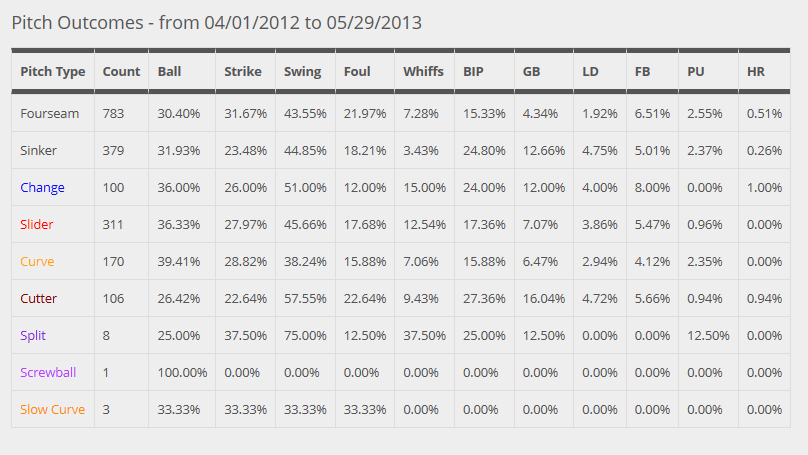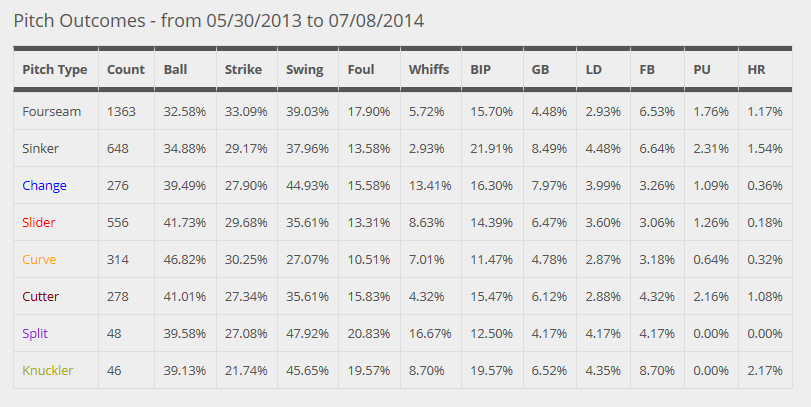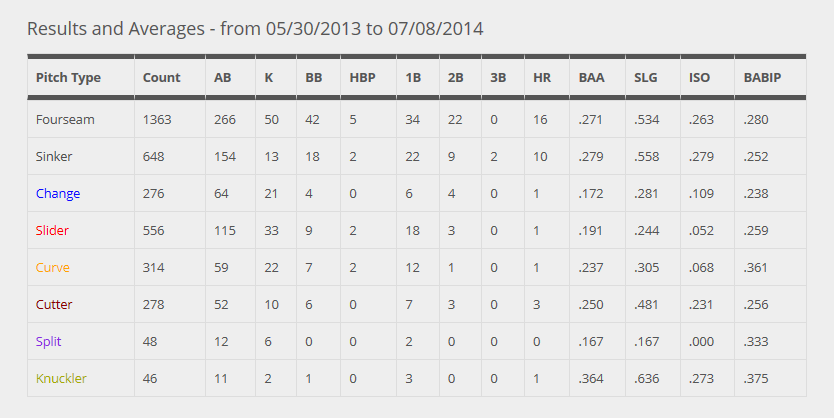
F/F Spotlight: Brian Dozier
Coming up as a shortstop, Brian Dozier (2B, MIN) was never viewed as a power threat. He averaged just four home runs per year in college at Southern Mississippi, then had a career high of nine in the minors (in 2011). Throughout his minor league career, he hit just 16 home runs in 1,405 at-bats (1 per 87.8 AB). Therefore, it wasn't surprising when he began his big league career with six home runs in 316 at-bats as a rookie in 2012, then just one in his first 147 at-bats in 2013.
However, after Dozier took Kyle Lohse deep in the fourth inning on May 30, 2013, he went on a home run tear, hitting 17 home runs in his final 411 at-bats. The Baseball Forecaster, like others, warned against buying too much into the power surge, though, saying:
Plenty of reason to be skeptical of this apparent breakout? xPX doesn't believe power is for real, though 2H fly balls helped. Middling batting average shows little sign of upside. And platoon splits are huge -- he batted more than 100 points higher vs LHPs. The safe play is to drop out when the bidding hits double-digits.
But to begin the 2014 season, Dozier picked up right where he left off. He has 16 home runs already, and has thrown in 15 steals as well. He's been one of the most valuable second basemen in the game, and has earned a significant profit for his owners. Can it last?
Year AB HR SB BA xBA OBA bb% ct% Eye G/L/F PX xPX hr/f Spd SBO
===== === == == === === === === === ==== ======== === === ==== === ===
2012* 497 7 11 223 232 264 5 81 0.29 42/21/38 65 80 6% 108 15%
13 1H 228 7 6 228 239 302 10 79 0.49 42/19/39 90 94 10% 140 20%
13 2H 330 11 8 255 268 311 8 78 0.38 35/22/43 138 102 10% 113 13%
2014 341 16 15 235 252 338 13 77 0.66 38/19/42 118 100 14% 103 20%
*Includes MLEsDozier continues to hit for a low batting average, and both xBA and a consistently mediocre contact rate indicate that it will probably stay that way. He's currently hitting slightly below his xBA, but that's consistent with his history to this point. Despite the low average, there's a lot to like in his BPIs.
Dozier didn't display much power early on in 2013, but then began hitting the ball in the air more, and with greater authority. He has maintained those fly ball gains thus far in 2014, and a higher percentage of them have left the park. His current power metrics don't quite support the elevated hr/f, though, so that number is unlikely to remain at that level.
The above table doesn't completely capture the magnitude of his post-May 2013 breakout. Here's a look at his monthly splits from 2013, which shows the drastic change in his production beginning in June:
Month AB HR BA xBA bb% ct% Eye HctX G/L/F PX xPX hr/f ===== === == === === === === ==== ==== ======== === === ==== April 70 0 243 211 8 80 0.43 78 37/23/40 40 91 0 May 84 2 190 216 3 75 0.14 67 52/15/34 66 66 10 June 74 5 257 290 17 81 1.07 117 27/20/43 160 127 19 July 96 2 240 286 6 81 0.33 93 33/25/42 140 110 6 Aug 127 6 276 292 8 78 0.39 108 31/25/45 179 116 13 Sept 107 3 243 220 9 77 0.40 69 43/16/41 85 77 9
Dozier put on a very impressive power display in June, July and August prior to fading in September. He credits much of his success to extensive film study that he and hitting coach Tom Brunansky began just a few weeks before the home run binge. A mechanical tweak (keeping his foot down) supposedly allowed him to recognize pitches better. And the numbers support his more patient approach (data courtesy of FanGraphs.com).
Plate Discipline Metrics
Year O-Swing% Z-Swing% Swing% Contact% P/PA
==== ======== ======== ====== ======== ====
2012 34.7 61.8 48.0 76.0 3.69
2013 28.9 54.0 40.0 76.6 4.17
2014 28.5 51.0 38.5 80.4 4.20
O-Swing% - Percentage of pitches a batter swings at outside the strike zone (League average is 30.3%)
Z-Swing% - Percentage of pitches a batter swings at inside the strike zone (League average is 65.2%)
Swing% - Total percentage of pitches a batter swings at (League average is 46.2%)
Contact% - Total percentage of contact made when swinging at all pitches (League average is 79.5%)
P/PA - Pitches per plate appearanceBatting at the top of the order, Dozier's top priority is getting on base, and becoming more patient has greatly improved that area of his game. In 2014, he's swinging at barely half of all pitches he sees within the strike zone, and is laying off pitches outside the zone as well.
Dozier's walk rate increased over the final four months of 2013, and he's taken a huge step up in 2014. He entered this season with a 7% walk rate for his career, and a poor .297 on-base-percentage in 963 plate appearances. By increasing those marks to 13% and .338, he has become a much more valuable player, in both real life and fantasy baseball.
Below is further evidence that Dozier's approach has changed dramatically, courtesy of brooksbaseball.net: The first table shows all of his plate appearances through May 29, 2013, while the second shows everything since then.


This data also shows that Dozier has been willing to take a lot of pitches, and that he's recognizing the pitches better. Since May 30, he's swinging less at every pitch type than he had previously. The drop-off in swing percentage on cutters has been the most significant, down from 57.55 percent to 35.61 percent.
In the first data set, Dozier swung at 44.41 (258/581) percent of the combination of changeups, sliders, and curves. Since then, he's offered at just 35.51 percent of those pitches (407/1,146). Continuing to lay off the off-speed stuff is key, because, as you'll see below, he doesn't have a great deal of success against those pitches.
Against the hard stuff (fourseam, sinker, cutter), Dozier is also swinging less, but the difference is much smaller. Of more significance is that he's cutting down on the swings and misses, while at the same time hitting them out of the park at a much higher rate.

The Speed Game
The dramatic rise in the number of times Dozier reaches base has allowed him to utilize his speed more. He stole 24 bases in the minors in 2011, and the following is an excerpt from his player commentary in the 2012 Minor League Baseball Analyst:
Steals bases more on instincts than speed, but has enough speed to post double-digit SB.
Dozier's speed metrics have since remained slightly above average, though it hasn't always translated to a great deal of success on the base paths. Over the next season and a half, he stole 18 bases in 28 attempts (15 for 23 in majors), good for a 64% success rate. That includes the first half of last season, when he was successful on just six of 12 attempts.
Dozier went on to steal eight bases in the season's second half, and was caught just once. He has been fairly efficient in 2014 as well, with 15 steals in 20 attempts so far. That comes to he's 23 for 29 (79 percent) since the middle of last year. If the walk gains hold up, and he continues with his improved success rate, a 30-steal season is well within reach.
Causes for Concern?
Dozier has clearly taken a step up in the power department, and is currently on pace for 29 home runs this year. But there are some cautions in his profile.
First of all, according to baseballheatmaps.com, Dozier's average fly ball travels just 275.6 feet, which ranks 168 out of 266 qualifiers in the majors. A high percentage of his fly balls don't even reach the outfield, as his current 13.5% infield fly ball rate ranks 23rd in the majors. As mentioned earlier, his elevated home run per fly ball rate is likely to see some regression.
Second, Dozier also plays in a home park in Target Field that favors pitchers. He has hit nine of his 16 homers at home this year, but given that it reduces right-handed home runs by nine percent, that pace may be unsustainable.
Also of some concern is Dozier's complete lack of power over the past few weeks. Dating back to June 15th, he's hit .202/.287/.270 with four extra base hits (one home run) in 89 at-bats. Granted, it's a fairly small sample, but given the questions surrounding his power just a couple months ago, there's no guarantee of a major rebound.
Conclusion
Given his mediocre track record, the doubts surrounding him heading into the season, and the recent slump, it's easy to predict regression for Dozier. However, while he's likely to end up falling a bit short of his current pace, there's plenty of reason for optimism. He has developed a very attractive power/speed combo, and is finding ways to take full advantage of those strengths..
Dozier has become much more of a power hitter than anyone expected him to be. While it's not clear whether this level of production will continue, most signs are pointing to him sustaining the majority of his gains. His pitch recognition seems to have improved, so he's getting better pitches to hit, and seeing much improved results. While 30 home runs might be a stretch, but there's mounting evidence that he can be a contributor in that category.
Dozier is never going to be much help in the batting average category, given his consistently low contact rate. However, he's been doing a nice job of getting on base this year, thanks to a big jump in his walk rate. That has paid huge dividends, as it's led to an increase in his stolen bases. While he doesn't possess elite speed, it's above league average, and he's evolving into a better base runner.
Add it all up and it looks like Dozier has a strong chance of putting up similar numbers going forward. He is likely to continue providing both power and speed, while remaining among the league leaders in runs scored. In other words, even if his pace slows a bit, he'll still end up one of the big surprises in 2014.







